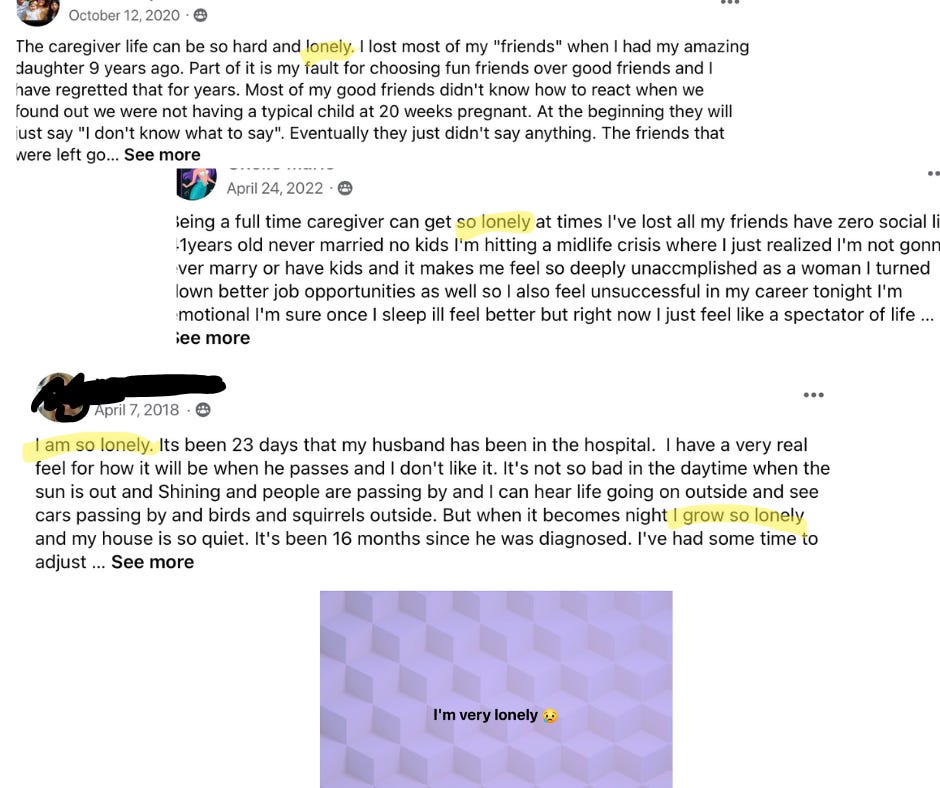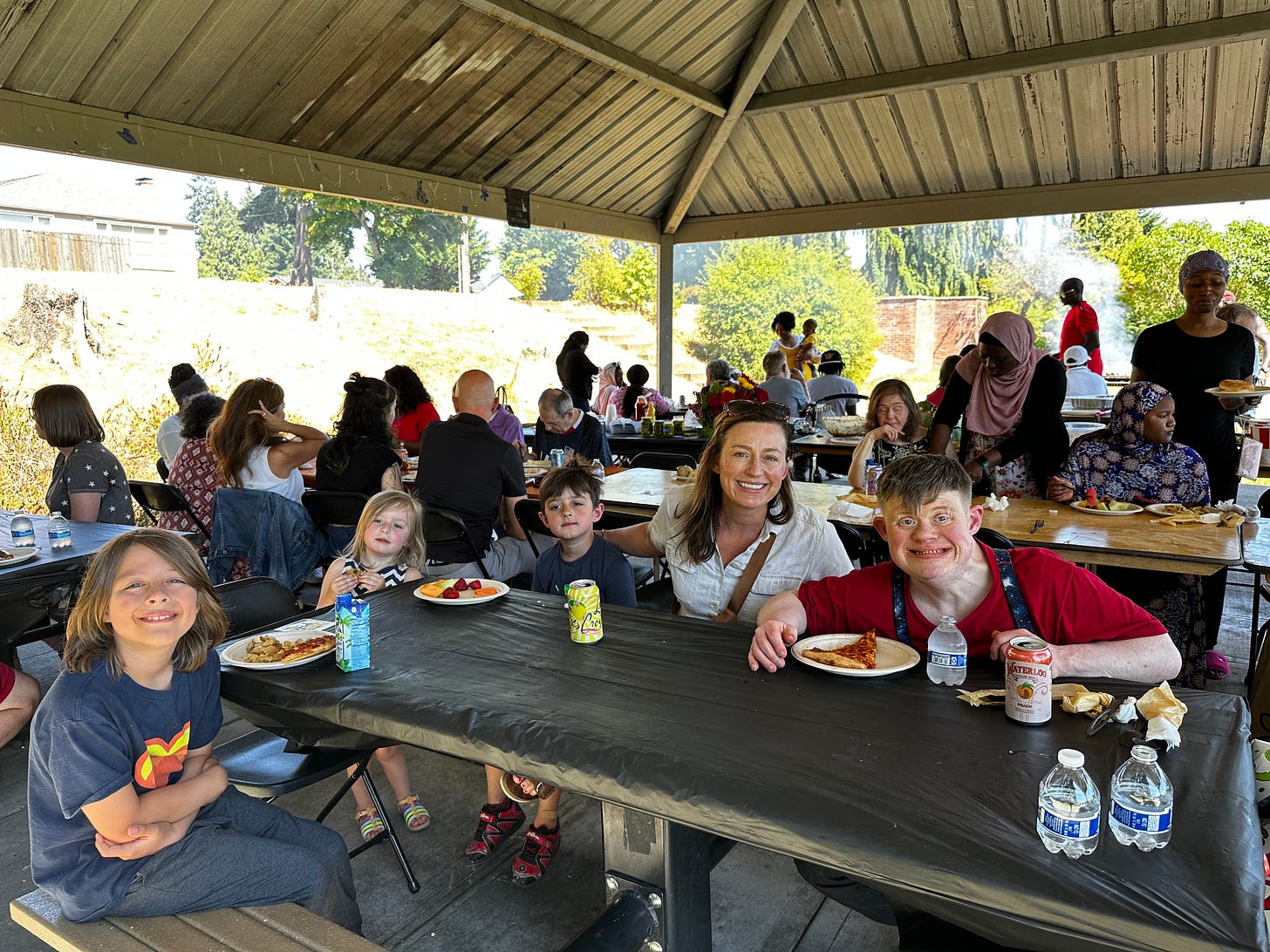Fictive Kin and Care Communities
Loneliness in America is real. Can innovative communities of care provide hope for social connection as medicine?
Take a glimpse into the online world of caregiver support groups, and an overarching theme is loneliness. By nature of the amount of time it takes, the physical and emotional exhaustion it causes, and in some cases the need to be with those who are cared for around the clock, caregivers often feel “trapped” - both physically with someone, but also in their emotional solitude. It’s a situation that is hard to understand until you’re in it, though many of us came closer to the feeling during the pandemic, as our bubbles became smaller and we dealt with illness and loss.
The truth is, a loneliness epidemic has been in the making in the US since before covid-19, even for those without caregiving needs or obligations. When my mom initially went into the hospital, it became painfully clear just how few close relationships she had. She had not called a friend, but taxi to take her to the hospital, and had only a handful of friends checking in on her while there. I don’t think her situation is that unique.
Back in May, the U.S. surgeon general Dr. Vivek Murthy released an advisory on the devastating impact of the epidemic of loneliness and isolation, citing that half of adults in the US reported experiencing loneliness and isolation even prior to the pandemic. Beyond self-defined loneliness, the related time use data is staggering: in the past two decades, Americans are spending 24 additional hours per month alone, and 20 hours per month less with friends. The report emphasizes the health implications when our human needs for social connection are not met:
Loneliness is far more than just a bad feeling—it harms both individual and societal health. It is associated with a greater risk of cardiovascular disease, dementia, stroke, depression, anxiety, and premature death. The mortality impact of being socially disconnected is similar to that caused by smoking up to 15 cigarettes a day, and even greater than that associated with obesity and physical inactivity.
Beyond the direct health implications, the report attributes $6.7 Billion in excess medicare spending and $154 Billion in stress-related worker absenteeism annually to social isolation.
So back to the context of caregiving: is caregiver loneliness mostly about the caregiving experience, or is it about experiencing the hardships of life, including caregiving, in isolation? I feel fortunate not to be isolated in my care sandwich; I have a loving husband and kids that make up a full, chaotic house. I have wonderful relationships with friends. But I have at times felt alone in my experience of the emotional rollercoaster and in my unique challenges as a mom of young kids who is also caring for disabled and elder family members.
One big challenge for Sandwich caregivers is that building communities and nurturing friendships becomes harder as we get older. The world has also changed a lot, especially for Xennials: our upbringing was low tech, we ran over to our friends’ houses unannounced, adults just showed up and rang the doorbell to say hello. I can’t remember the last time a friend just stopped by my house, unannounced. The various opportunities for “bonding social capital” seem to have decreased steadily along with the rise of technology. But it’s hard - maybe impossible - to go back. We need to forge a new way.
Rethinking communities of care
There’s a question that has come up regularly in my conversations in the last several years, particularly with other parents: what is the atheist version of church? That is, a community with whom you have shared values and interests, regular opportunities for interaction and bonding, trust and where there is an unstated and unconditional understanding that you’ve got each others’ backs in times of need - aka “generalized reciprocity” - without the religious doctrine? How can we cultivate more secular, chosen communities in a time where calling someone out-of-the-blue, without a prearranged phone date, feels almost like a faux pas (unless it’s your parents)?
Assisted Living homes for disabled and elderly folks are both examples of non-familial, (usually) secular communities where those in need of care can have their care and social needs met. Many non-western cultures where (female) family is entirely depended upon for care view care homes as somehow cruel. Personally I’m very grateful that my developmentally disabled brother is part of a community that ensures he gets plenty of opportunity to connect with others and participate in meaningful activities. He goes to yoga classes, attends organized social gatherings, and has a care team to look out for and spend time with him. I’m not sure how my family would have managed without this placement for him, and he has benefitted from from the increased level of supported independence it allows.
However, assisted living communities are only for those in need of care, they don’t provide community for others’ who may need solidarity as they provide care, or who are looking for non-familial community, or ‘fictive kin’. Assisted living communities are established for the purpose of providing paid caregiving to physically or developmentally unable to care for themselves, which comes with inherent power and economic implications.
There are some historic and contemporary examples we can learn from. I’ve been reading recently about the beguines in Europe during the Middle Ages. They were houses or entire towns of women living in community, often following religious principles of caring for the poor or ill, heavily involved in arts and education, but entirely independent of the church and free from vows of chastity and piety. They have been described as “the freest women of medieval times” - living the way they wanted to live, free from existing power structures but in community with like minded folks.
The Older Women’s Co-Housing (OWCH) project in London is a community exclusively for women over 50 - but by no means assisted living. This type of co-housing arrangement is formed on the idea of a community of people looking out for each other, not after each other. Even though family or carers may come in to help residents who need it, the residents have community to depend on beyond their carers. Similar housing arrangements have been set up in the Netherlands, Denmark and elsewhere. One of the project’s facilitators shared in the Guardian:
“The women who started this were adamant that they didn’t want to sit in a day-room singing Daisy Daisy and Pack Up Your Troubles for the rest of their lives,” she says. “We were fiercely opposed to the ageism and paternalism, the infantilisation of older people by social care services.”
In Bogota, Colombia, the city’s progressive female mayor is experimenting with a community-level solution to the intertwined problems of unpaid care work, poverty and gender inequity: care blocks. In Ciudad Bolívar, there is a city-funded laundromat where women can drop off clothes, a community center offers city-funded care for children and elderly/disabled dependents while women attend free courses to earn high school diplomas, practice yoga, or learn to use a computer or cellphone. A full range of health services including STD testing, psychological counseling, pediatrics and OBGYN services are offered all under one roof. The Washington Post writes:
“A care block is a modest attempt to shift the way caregivers are viewed and supported, and the way they view themselves. It’s a community-scale solution — something that’s needed if poor women are to benefit from global progress in gender equality.
These examples give me hope. They meet our human needs for care and kinship, while maintaining the autonomy and empowerment of those involved. In the face of shifting family structures and demographics, we are going to see (and require) many more creative community solutions like these to in order to ensure both carers and those needing care can physically and emotionally thrive.
Do you know of other innovative care community solutions? I’d love to hear about them! Please share them in the comments or reply to this email.
***
📚 Reads
Re-examining the concept of care: Three conversations leaders can have with employees
Opinion: In Bogota’s Poorest Quarters, Women Glimpse a Future with More Choices
‘We Have Brothers, Sons, Lovers - but They Can’t Live here!’ The Happy Home Shared by 26 Women







Thanks for another insightful and thought-provoking read, Anna! Another interesting elder care model I’ve read about is the village movement. It’s basically neighbors organizing to look after and support each other, and it sounds pretty wonderful. Here’s some info on it: https://www.vtvnetwork.org/content.aspx?page_id=22&club_id=691012&module_id=248578
I hope someone is doing an evaluation. I’m so curious what happened to the commercial lavanderías in the neighborhood. Were they invited to participate? Compensated? It’s hard to imagine something like this gaining scale unless it’s a full-on socialization of the laundry, yoga, and childcare industries. I’d be all for it, but doesn’t seem like a political winner in most places. I wonder if the closest we have to this in the US is the way that libraries are expanding to provide more and more services?